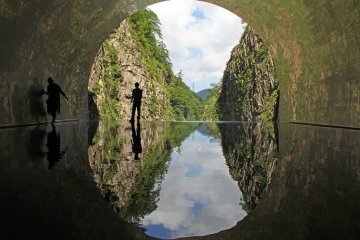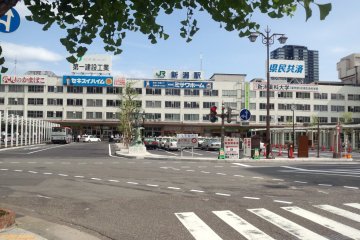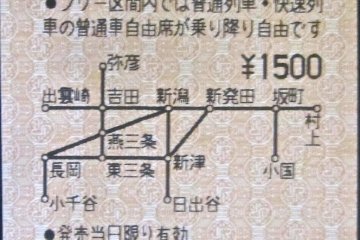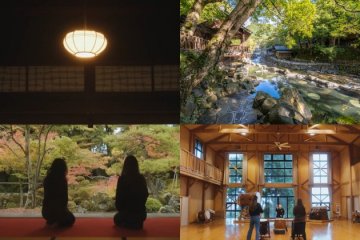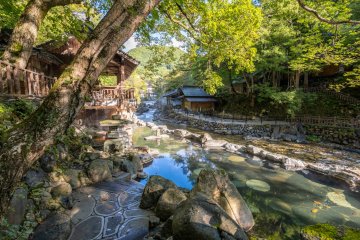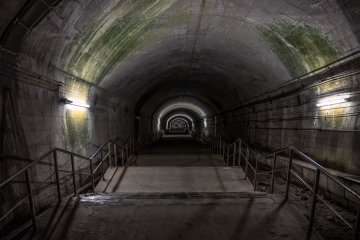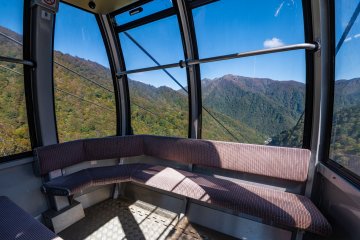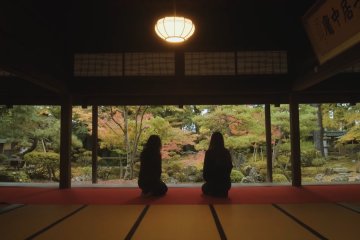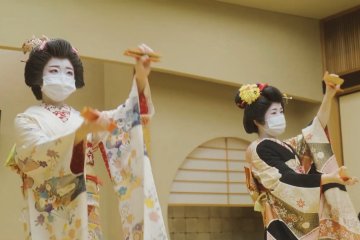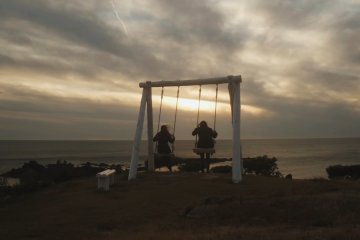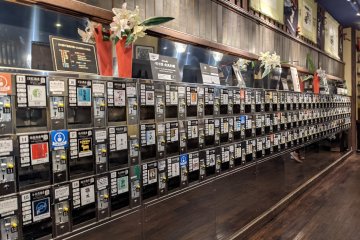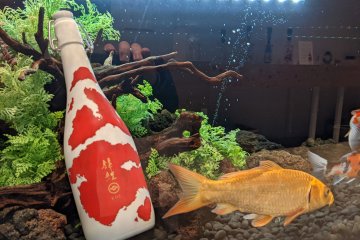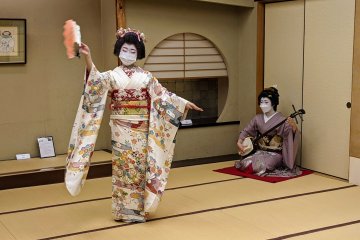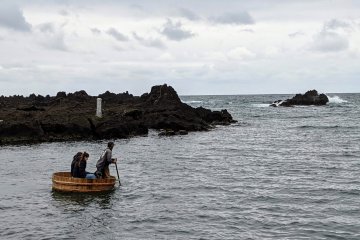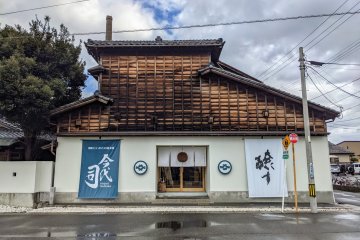The Jōetsu Shinkansen is a high-speed bullet train route that connects Tokyo—Japan’s capital that sits near the Pacific Ocean—with Niigata prefecture in the north, along the Sea of Japan.
In just a little over two hours, trade the hustle and bustle of Tokyo for Niigata’s vibrant coastline in a journey that takes you through mountainous Gunma and across the Echigo plains.
But they say life is about the journey—not the destination—so we recommend adding a stop or two along the way after departing from Tokyo Station. Better yet, holders of the JR Pass, JR Tokyo Wide Pass or JR East Welcome Rail Pass will be able to travel this route for no additional cost, allowing you to ride and disembark the train at any stop you please.
Here are our recommendations:
Minakami
Minakami has long been considered an outdoor adventure capital and a popular getaway destination in its own right for those in Tokyo. It’s also home to some stunning hot spring resorts and unique attractions that make it a worthy pit-stop on any journey to Japan’s northern coast. Tokyo to Jomokogen Station takes just 1h5m along the Joetsu Shinkansen.
Takaragawa Onsen

Takaragawa Onsen is a well-known hot spring resort to Japanese people, with its picturesque, autumnal riverside landscape nestled deep in the mountains often featured in the occasional Japanese drama. Added to this, Takaragawa is also relatively unique for its many mixed-gender (konyoku) outdoor pools that line the Takara River. Ryokan guests of Takaragawa Onsen Osenkaku, wearing special bathing towels, have free access to most of these rotenburo baths (one is female only) making for a unique experience and possible nervy—but fun—encounter for hot spring newcomers.
Follow a soak in the onsen by dining at the ryokan’s restaurant where you can expect a decadent kaiseki-style course of Japanese dishes inspired by the season and local ingredients. Retire to a comfy tatami room where your futon has been magically prepared for the long slumber ahead, with the gentle, soothing ripple of the passing river a perfect soundtrack to a night’s sleep.
Getting there: Overnight guests at Takaragawa Onsen Osenkaku can handily reserve a direct shuttle bus from either JR Jomo-Kogen Station or JR Minakami Station.
Takuminosato: craft capital of Gunma

Takuminosato provides a traditional setting where you can hands-on experience Japanese crafts, set to the backdrop of Gunma’s mountains. This rustic, quiet community is a collection of four villages and promises the chance to try woodwork, bamboo, washi papermaking, dyeing, weaving, soba making and even glass blowing. It would be easy enough to spend the whole afternoon here—especially if travelling in a group—but trying just one activity is a great way to craft your very own souvenir
Getting there: 15 min drive west of Jomo-Kogen Station.
Doai Station

And now for something a little different: welcome to Japan’s deepest station! You won’t necessarily need to catch a train here—a local stop on the JR Joetsu Line—but consider a quick visit before journeying to nearby Tanigawadake. Marvel at this unmanned, retro station that has been operating since 1936 and whose passageway to the platform just endlessly descends into the depths of Gunma’s mountains. If you decide to brave the 486 steps down to the Niigata-bound platform, just know there are no elevators or escalators back up.
Tanigawadake Ropeway

Mount Tanigawa presents a wonderful hiking opportunity, but for those short of time the ropeway provides quick access to some of the best natural views in this part of Gunma. Once at the top, you can enjoy a short hike in the area or take a further skilift to reach an even higher vantage point. Autumn promises a carpeted landscape of reds, oranges and yellows, with skiing possible from December through May.

Kayaking
You can’t visit Minakami without getting a little bit adventurous (although the mixed onsen of Takaragawa certainly may count!). ‘Fantail’ is an outdoor nature guide that specialises in canoeing, kayaking and trekking.

After a 30-minute drive east of Doai Station, you’ll arrive at Fantail’s Dogen Lake Canoe Base, from where you can gear up and embark to Naramata Lake to hit the waters! On a sunny day, expect to feel enveloped by nature as you navigate the lake’s surface under the guidance of instructor, Saito-san.
On to Niigata:
From Jomo-Kogen, it’s a one hour journey by Joetsu Shinkansen.
Niigata
Mention Niigata and images of sake and rice quickly come to mind for local Japanese people — this prefecture is one of the biggest producers in Japan of these two staple products, embedded into every facet of daily life in Japan, thanks to its abundant, natural and high-quality water. For others, the prefecture’s water is more synonymous in frozen form for its skiing and snowboarding potential at one of the prefecture's many ski resorts, with music festivals like Fuji Rock also proudly hosted here.
Northern Culture Museum

Once home to the Ito Family—the wealthiest landowners in Echigo (modern-day Niigata)—the Northern Culture Museum exhibits successive generations of the family’s collection of artworks and antiques, over 6,000 of them from across Japan, China and Korea. Marvel at the Meiji-period architecture on display too: the traditional Japanese-style wooden home is built on a 29,100 square meter site with 65 separate rooms. Perfectly landscaped gardens surround the estate, known to be beautiful in all four seasons but particularly spectacular to admire during the autumn from the main Ito Residence’s Banqueting Hall.
Furumachi Geigi: Niigata’s Geisha Culture

Unlike their illusive counterparts in the geisha heartland of Kyoto, Niigata’s geisha—known as geigi—are relatively straightforward to appreciate. Why not book up a luxurious Japanese lunch or dinner, and sit back to a unique geisha performance? The geigi keep alive a local entertainment tradition that dates back over 300 years. Operating around the Furumachi (‘old town’) area along Furumachi-dori, Niigata’s geisha performances can be enjoyed at a number of local kappo (type of high-end Japanese-style restaurant), such as Kappo Hotaru or Kappo Daizen.

Advance booking is essential, but alongside a full-course menu you can expect to experience geisha performances such as shamisen and dance, enjoy traditional games, and even chat to the geisha themselves (if you can manage Japanese—or via an interpreter!) and take photos at the end. What’s more, Niigata’s Geigi experiences are known for being much cheaper and easier to book than comparable performances by geisha in Kyoto, making this culture accessible to more and more people.
Imayo Tsukasa Sake Brewery

If you want to get the quintessential “Niigata sake” experience, consider visiting Imayo Tsukasa Sake Brewery. They’ve been brewing sake since 1767 and still rely on traditional techniques to this day, nor rely on any artificial ingredients. Take a look for yourself, with free brewery tours that outline how sake is made, the history of the brewery and the chance to taste several varieties of sake yourself.

In the shop, you’ll quickly realise how many brands of sake they produce — with some of their award-winning varieties particularly well-known, like the KOI carp-inspired bottle design.
Ponshukan

If Imayo Tsukasa Sake Brewery offers an insight into sake’s past, then Ponshukan shows you the present. This chain of Niigata brand shops can be found in several spots around the prefecture, but the Niigata Station location is perhaps most well-known and easiest to access. Taking Japan’s love of both sake and vending machines to the next level, Ponshukan’s wall of 90 sake vending machines is one of Niigata City’s raison d’être for many visitors. For 500 yen, get a tasting cup and five tokens — the rest is up to you. Every single variety is a native Niigata product.
Pia Bandai

This dockside marketplace is the place to go for food. With a selection of restaurants—from ramen to sushi to coffeeshops—and fresh food markets, expect to find the freshest Niigata-caught seafood and local produce available. Early mornings promise to be lively as the day’s fresh catch arrives, while you can also shop for souvenirs on the side.
On to Sado Island:
From Niigata Station it’s 10 minutes by taxi to Niigata Port.
Here you can board Sado Kisen’s car ferry service (2.5 hrs, 2,810+ JPY one-way) or jetfoil (1hr7m, 6,900+ JPY one-way).
These make the journey to Sado’s eastern Ryotsu port. The number of daily services changes with each season.
Sado Island
If heading north from Tokyo to Niigata, there’s no need to stop at the coast. Catch a ferry ride from Niigata Port to keep going onwards towards the beloved Sado Island, or Sadogashima.
This unique S-shaped island is built up around two mountain ranges (Osado and Kosado) that flank central fertile plains that lie home to the main regions of Ryotsu to the east, and Sawata/Mano areas to the west. It’s a nature treasure trove that was awarded Geopark status in 2013, and is known for its historical gold/silver mines, its species of toki (Japanese crested ibises) and taraibune tub boats that are ever so slightly reminiscent of Studio Ghibli’s ‘Spirited Away’ animated film.
Buses exist to get you around the island, but if you want to move reliably and promptly and see the best of what Sado has to offer, we recommend renting a car from one of several vendors near Ryotsu Port.
Shukunegi Village & Taraibune

Shukunegi is a small village area that prospered during the 17th century owing to the success of the local Sado Gold Mine. The village is characterized by over 100 houses densely packed into a small area, with narrow alleyways weaving between these unique architectural curiosities. With walls made from ship planks, they offer a glimpse into the area’s ship-related heritage. Shukunegi is designated a National Important Preservation Area for Traditional Buildings and Architecture.

Shukunegi is also one of the locations, along with Ogi and Yajima-Kyojima, where visitors to Sado Island can try the unique, local custom of riding taraibune, or tub boats.
Taraibune’s popularity came about due to an earthquake 200 years ago, making the coastal areas suddenly inaccessible to fishing boats. Taraibune was known to be more maneuverable, making them useful at gathering seaweed and shellfish — a technique still occasionally used today.
Each taraibune location is known as being slightly unique. Whereas many may recall the striking image of the tub boat and red bridge background—as seen at Yajima-Kyojima—as one reminiscent of ‘Spirited Away’, the Shukunegi location will see you board with the rider’s trusty companion dog which adds to the experience!
Sado Taiko at Tatakokan

Sado Island Taiko Center, nicknamed ‘Tatakokan’ (derived from the Japanese name), is the place to catch a unique and special workshop demonstration of this beloved, traditional and lively Japanese artform.
If you have ever come across ‘taiko’ in some form or another outside Japan, chances are this is in some part due to the global success of the local Sado-born taiko collective, ‘Kodo’. This taiko troupe has grown in stature and toured internationally for decades since their original debut at the 1981 Berlin Festival. Sado is the group’s home base where they have founded many activities, including the annual music festival, ‘Earth Celebration’.
Tatakokan offers a range of taiko experience programs for visitors to get to know how to play these special drums, but also hear a professional instructor demonstrate how they are played. The large hall here features two huge, centrepiece drums that were carved from an enormous 600-year old keyaki (zelkova) tree.
Kitazawa Flotation Plant (Remains)

Here you’ll find the mysterious overgrown remains of a 1930s flotation plant used to separate silver and gold from waste from the nearby Sado Kinzan (gold/silver mines), via flotation techniques originally designed for copper. On one hand a nod to Sado’s heyday, the location offers a stark reminder of the fragility of our culture. The buildings here take on an eerie, yet fascinating, appearance, having been slowly recovered by nature’s pull. Those who visit in the evening will be greeted by an illumination that fades through different colors.
Sado Onsen (Hotel Azuma)

What better way to close out a trip to Niigata’s island of Sado than with a stay at one of its top resorts. Hotel Azuma, on the north-western tip of the island, offers a stunning coastal setting amidst refined, cozy surroundings thanks to the modern-traditional Japanese rooms. Watch the sun go down from the comfort of the outdoor rotenburo hot spring or the giant swing in the garden, before heading indoors for a lavish dinner — don’t forget to catch the Sado Okesa dance workshop in the foyer to catch a local custom up close!
Farewell Sado Island: see you again!



